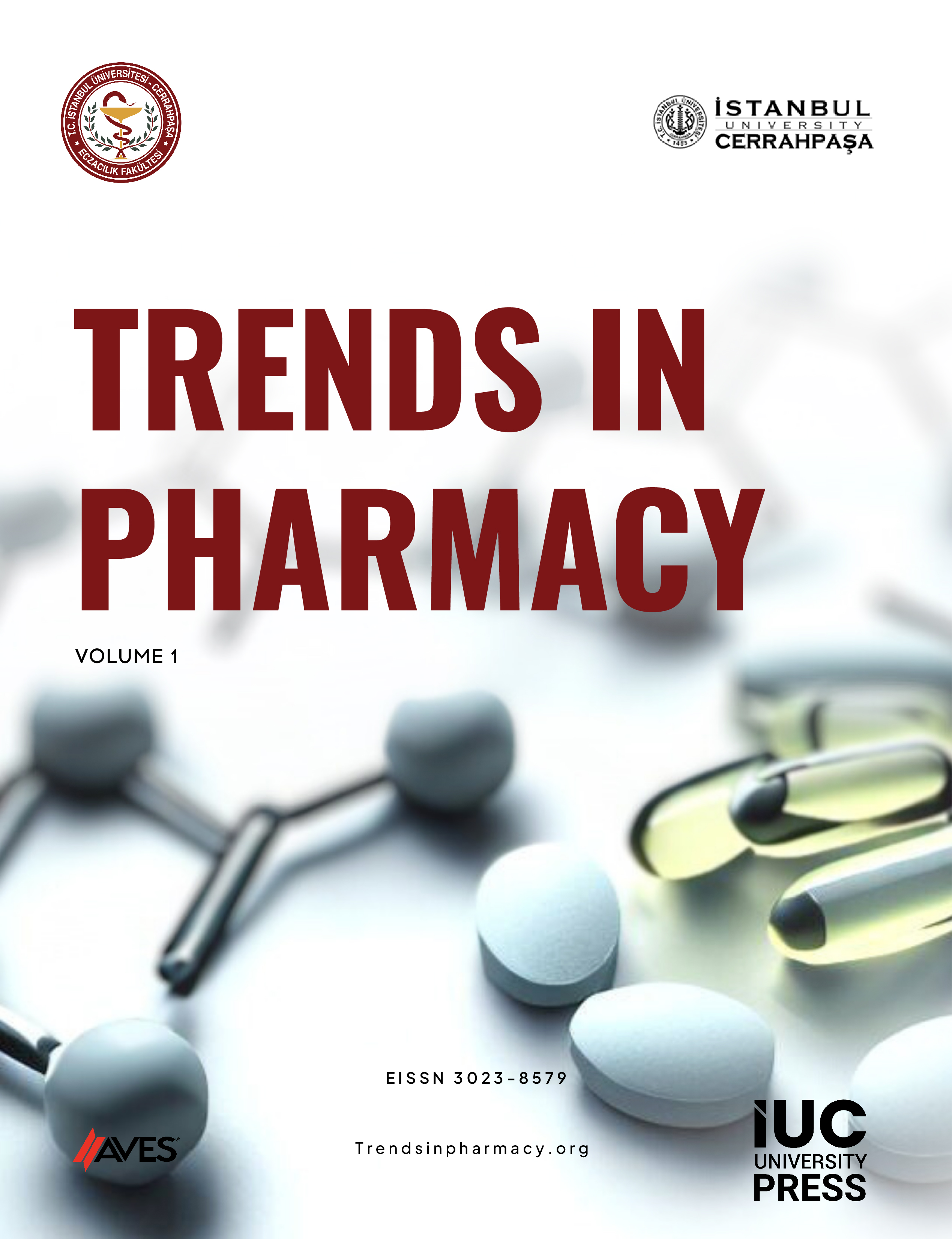
Assessment of the Antimicrobial and Antibiofilm Activities of Trigonella smyrnea Boiss. Growing in Türkiye
Main Article Content
Abstract
Background: The aim of this study is to assess the antimicrobial and antibiofilm capabilities of Trigonella smyrnea Boiss. plant species.
Methods: The antimicrobial activity of an ethanol-derived extract from the aerial parts, seeds and seed coat of Trigonella smyrnea were tested using the microdilution technique against 5 reference bacteria and three yeast strains. Additionally, the ability of the extracts to inhibit both biofilm formation and pre-formed biofilms produced by Pseudomonas aeruginosa was assessed using the crystal violet method.
Results: The utilized samples exhibited mild to moderate antimicrobial activity against the examined bacteria and yeasts, with minimum inhibitory concentration (MIC) values ranging from 250 to 62.5 µg/mL. The aerial parts, seed and seed coat extracts inhibited biofilm formation by approximately 36%, 28%, 40% and 30%, 25%, 33% at MIC/2 and MIC/4 MIC, respectively. In addition, preformed biofilm inhibition rates of aerial parts, seed and seed coat extracts were MIC/2: 11%, 26%, 26%; MIC: 15%,
30%, 31% and in 2×MIC: 31%, 38%, 38%, respectively.
Conclusion: Our data indicates that the extracts have mild to limited antimicrobial activity and moderate potential in combating biofilm formation. Especially when compared to seed extract, aerial parts and seed coat extracts showed better antibiofilm activity. In conclusion, although extracts of this species are promising in terms of antibiofilm activity, these findings should be supported by further study.
Cite this article as: Uras Güngör ŞS, Öksüz Z, Assessment of the antimicrobial and antibiofilm activities of Trigonella smyrnea boiss. growing in Türkiye. Trends Pharm. 2024, 1, 13, doi: 10.5152/TrendsPharm.2024.23013
Article Details
References
1. Meade E, Slattery MA, Garvey M. Bacteriocins, potent antimicrobial peptides and the fight against multi drug resistant species: Resistance is futile?. Antibiotics. 2020;9(1):32. [Crossref]
2. Del Pozo JL. Biofilm-related disease. Expert Rev Anti Infect Ther. 2018;16(1):51-65. [Crossref]
3. Ibberson CB, Whiteley M. The social life of microbes in chronic infection. Curr Opin Microbiol. 2020;53:44-50. [Crossref]
4. Melander RJ, Basak AK, Melander C. Natural products as inspiration for the development of bacterial antibiofilm agents. Nat Prod Rep. 2020;37(11):1454-1477. [Crossref]
5. Hengzhuang W, Wu H, Ciofu O, Song Z, Høiby N. In vivo pharmacokinetics/pharmacodynamics of colistin and imipenem in Pseudomonas aeruginosa biofilm infection. Antimicrob Agents Chemother. 2012;56(5):2683-2690. [Crossref]
6. Guzzo F, Scognamiglio M, Fiorentino A, Buommino E, D'Abrosca B. Plant derived natural products against Pseudomonas aeruginosa and Staphylococcus aureus: Anti-biofilm activity and molecular mechanisms. Molecules. 2020;25(21):5024. [Crossref]
7. Lagha R, Abdallah FB, Al-Sarhan BO, Al-Sodany Y. Anti-bacterial and biofilm inhibitory activity of medicinal essential oils against Escherichia coli isolated from UTI patients. Molecules. 2019;24(6):1161. [Crossref]
8. Husain FM, Ahmad I, Khan MS, Al-Shabib NA. Trigonella foenum-graceum (seed) extract interferes with quorum sensing regulated traits and biofilm formation in the strains of Pseudomonas aeruginosa and Aeromonas hydrophila. Evid Based Complement Alternat Med. 2015;2015:879540. [Crossref]
9. Fierascu RC, Fierascu I, Baroi AM, Ortan A. Selected aspects related to medicinal and aromatic plants as alternative sources of bioactive compounds. Int J Mol Sci. 2021;22(4):1521. [Crossref]
10. Akan H, Ekici M, Aytaç Z. The synopsis of the genus Trigonella L. (Fabaceae) in Turkey. Turkish Journal of Botany. 2020;44:670-693. [Crossref]
11. Güzel Kara S, Ülger M, Kahraman A. Phytochemical analysis, antioxidant and antimicrobial activities of Salvia virgata mericarps. Botanica Serbica. 2021;45(2):223-233. [Crossref]
12. Woods GL, Washington JA. Antibacterial susceptibility tests: Dilution and disk diffusion methods. In: Murray PR, Baron EJ, Pfaller MA, Tenover FC, Yolken RH, eds. Manual of clinical microbiology. 6th ed. Washington, DC: American Society for Microbiology; 1995. p.1327-1341.
13. Jorgensen JH, Ferraro MJ. Antimicrobial susceptibility testing: General principles and contemporary practice. Clin Infect Dis. 1998;26:973-980. [Crossref]
14. O'Toole GA. Microtiter dish biofilm formation assay. J Vis Exp. 30;(47):2437. [Crossref]
15. Gomes F, Martins N, Ferreira ICFR, Henriques M. Anti-biofilm activity of hydromethanolic plant extracts against Staphylococcus aureus isolates from bovine mastitis. Heliyon. 2019;5(5):e01728. [Crossref]
16. Zhong H, Xie Z, Wei H, et al. Antibacterial and antibiofilm activity of Temporin-GHc and Temporin-GHd against cariogenic bacteria, Streptococcus mutans. Front Microbiol. 2019;10:2854. [Crossref]
17. Salam SGA, Rashed MM, Ibrahim NA, Rahim EAA, Aly TAA, Al-Farga A. Phytochemical screening and in-vitro biological properties of unprocessed and household processed fenugreek (Trigonella foenum-graecum Linn.) seeds and leaves. Sci Rep. 2023;13(1):7032. [Crossref]
18. Yakout SM, Abd-Alrahman SH, Salem-Bekhit MM, Mostafa A. Chemical characterization and antibacterial activity of ethanolic extract of Trigonella foenum-graecum (fenugreek) seeds. J Pure Appl Microbiol. 2013;7(2):1373-1378.
19. Kadaikunnan S, Rejiniemon TS, Alharbi NS, Khaled JM, Agastian P. Identification and quantification of phenolic compounds from Trigonella foenum-graecum L. and its in-vitro antioxidant, anticancer and antimicrobial activities. Fresenius Environ Bull. 2015;24:2643-2649.
20. Akbaş P, Atila G, Uslu H, Alkan H. Trigonella foenum-graecum L. (çemen) tohum ekstraktının antimikrobiyal aktivitesinin tayini. Caucasian J Sci. 2017;4(1):57-61.
21. Al-Timimi LAN. Antibacterial and anticancer activities of fenugreek seed extract. Asian Pac J Cancer Prev. 2019;20(12):3771-3776. [Crossref]
22. Singh N, Yadav SS, Kumar S, Narashiman B. Ethnopharmacological, phytochemical and clinical studies on Fenugreek (Trigonella foenum-graecum L.). Food Biosci. 2022;46:1-31. [Crossref]
23. Uras Güngör ŞS, Öksüz Z. Trigonella cylindracea Desv.'nin farklı kısımları üzerine in vitro çalışmalar: Antimikrobiyal ve antibiyofilm aktiviteleri. Icontech Int J Surv Eng Technol. 2022;6(3):59-67. [Crossref]
24. Uras Güngör ŞS, Öksüz Z. Trigonella strangulata Boiss.'nın farklı kısımlarından elde edilen etanol ekstrelerinin antimikrobiyal ve antibiyofilm aktivitelerinin değerlendirilmesi. In: Işık B, Köse F, Küçüktürk S, eds. Sağlık Bilimlerinde Güncel Tartışmalar. İzmir: Duvar Yayınları; 2022:101-114. [Crossref]
25. Thi MTT, Wibowo D, Rehm BHA. Pseudomonas aeruginosa biofilms. Int J Mol Sci. 2020;21(22):8671. [Crossref]
26. Ben Haj Khalifa A, Moissenet D, Vu Thien H, Khedher M. Virulence factors in Pseudomonas aeruginosa: Mechanisms and modes of regulation. Ann Biol Clin (Paris). 2011;69(4):393-403. [Crossref]
27. Husain FM, Ahmad I, Khan MS, Al-Shabib NA. Trigonella foenum-graceum (Seed) extract interferes with quorum sensing regulated traits and biofilm formation in the strains of Pseudomonas aeruginosa and Aeromonas hydrophila. Evid Based Complement Alternat Med. 2015;2015:879540. [Crossref]

